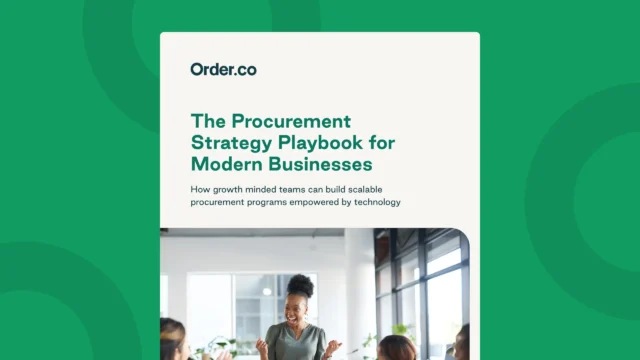How to Implement Procure-to-Pay in Weeks, Not Months: A Mid-Market Playbook

How to Implement Procure-to-Pay in Weeks, Not Months: A Mid-Market Playbook
Implementing a new software platform can feel daunting. For finance and operations leaders at growing mid-market companies, the fear of a long, disruptive rollout is a major barrier to fixing broken purchasing processes. You know you need to eliminate rogue spend and get control over your budget, but you can’t afford a project that drags on for months and pulls your team away from strategic work.
The good news is that it doesn’t have to be that way. While enterprise-level systems can take the better part of a year to deploy, a modern procure-to-pay (P2P) platform built for the mid-market can be up and running in a matter of weeks. With the right partner, a clear plan, and a focused pilot program, you can quickly move from purchasing chaos to complete spend control.
This playbook provides a comprehensive procure-to-pay implementation timeline and a practical pilot checklist to guide your team from initial planning to a successful company-wide launch.
Download the free ebook: The Procurement Strategy Playbook for Modern Businesses
What is a realistic procure-to-pay implementation timeline?
A realistic procure-to-pay implementation timeline for a mid-market company ranges from 4 to 12 weeks. The exact duration depends on factors like the complexity of your organizational structure, the number of software integrations required, and the scope of vendor onboarding. With a streamlined platform and a dedicated implementation partner, it's possible to achieve a rapid rollout and see value almost immediately.
Unlike massive enterprise resource planning (ERP) projects that can take 6-18 months, modern P2P solutions are designed for speed and agility. Key variables that influence your specific timeline include:
- Company Size: The number of users, departments, and physical locations that need to be configured.
- Workflow Complexity: The number and intricacy of approval chains and budget rules.
- Integrations: Connecting the P2P platform to your existing accounting or ERP system (e.g., NetSuite, Sage Intacct, QuickBooks).
- Vendor Management: The number of existing suppliers that need to be onboarded into the new system.
- Internal Resources: The availability of your project team to assist with discovery, testing, and training.
At Order.co, we specialize in helping mid-market businesses implement procure-to-pay in weeks, not months. Our white-glove onboarding process is designed to handle the heavy lifting, from vendor setup to user configuration, so your team can focus on a smooth transition.
The 4 phases of a successful P2P implementation
A successful P2P implementation follows four key phases: Discovery and Planning, Configuration and Integration, Pilot and Training, and Go-Live and Optimization. This structured approach ensures all stakeholders are aligned, the system is tailored to your needs, and your team is prepared for adoption.
Breaking the project into these manageable stages prevents overwhelm and keeps the implementation on track.
Phase 1: Discovery and planning (Weeks 1-2)
This initial phase is critical for setting the foundation for the entire project. The goal is to align all stakeholders on the project's objectives, scope, and success metrics. A thorough discovery process ensures the final solution solves your most pressing business challenges.
Key activities include:
- Needs Analysis: Document the specific pain points in your current purchasing process. Are you struggling with maverick spend, invoice overload, or a lack of visibility?
- Goal Setting: Define clear, measurable objectives. Examples include "reduce purchase order cycle time by 40%" or "achieve 95% spend on-contract with preferred vendors."
- Stakeholder Alignment: Assemble a cross-functional project team including representatives from finance, procurement, operations, and IT. Secure executive sponsorship to champion the initiative.
- Process Mapping: Outline your current and desired future-state P2P workflows, from requisition to payment.
- Vendor Selection: If you haven't already, use your defined requirements to build a request for proposal (RFP) and evaluate potential P2P software partners.
Phase 2: Configuration and integration (Weeks 2-5)
Once the plan is in place, your chosen vendor will begin configuring the platform to match your specific workflows and business rules. This is where a hands-on implementation partner makes a significant difference, as they can accelerate this technical setup.
Key activities include:
- System Configuration: Setting up user roles and permissions, building custom approval chains, defining budget controls, and configuring departments or locations.
- Accounting System Integration: Connecting the P2P platform to your ERP or accounting software to ensure a seamless flow of financial data for reconciliation and reporting. Proper integration is key to effective procurement automation.
- Vendor Onboarding: Migrating your existing vendors and their product catalogs into the platform. This is often the most time-consuming part of a self-managed implementation. A platform like Order.co, with a network of over 15,000 vendors and a dedicated onboarding team, dramatically reduces this burden.
Phase 3: Pilot and training (Weeks 6-8)
Before a company-wide rollout, a pilot program allows you to test the new system in a controlled environment. This is your opportunity to validate workflows, gather user feedback, and make necessary adjustments to ensure a smooth launch.
Key activities include:
- Pilot Group Selection: Choose a small but representative group of end-users who will actively use the system for their daily purchasing.
- User Training: Conduct hands-on training sessions for the pilot group and provide them with support documentation like quick-start guides and FAQs.
- Testing and Feedback: The pilot group tests all core functions, from creating a purchase request to approving an invoice. Their feedback is collected through surveys and interviews to identify any friction points.
Phase 4: Go-live and optimization (Weeks 9+)
After a successful pilot, it's time to launch the platform across the entire organization. The implementation doesn't end at go-live; it transitions into a phase of continuous improvement and value realization.
Key activities include:
- Phased Rollout: Launch the new system department by department or location by location to manage the transition effectively.
- Company-Wide Communication: Announce the launch and clearly communicate the benefits and changes to all employees.
- Performance Monitoring: Track your initial KPIs against the baseline to measure ROI and identify areas for improvement.
- Ongoing Support: Establish a clear channel for users to ask questions and get help as they adapt to the new process.
- Optimization: Use the data and insights from the platform to refine your procurement savings strategies, optimize vendor relationships, and further streamline workflows.
Your essential P2P pilot checklist for mid-market companies
The essential P2P pilot checklist for mid-market companies should focus on defining clear goals, selecting the right pilot group, testing core workflows, gathering structured feedback, and establishing success metrics before a full rollout. A well-executed pilot is the single best predictor of a successful P2P implementation.
Use this checklist to structure your pilot program and ensure you gather the insights needed for a confident, company-wide launch.
1. Define pilot scope and objectives
- Identify Test Cases: Select 1-3 specific, high-frequency purchasing scenarios to test (e.g., ordering office supplies, requesting new software, purchasing marketing materials).
- Set Success Criteria: Establish clear, measurable goals for the pilot. For example:
- Reduce average approval time for requisitions by 50%.
- Achieve a 90% user satisfaction rating from the pilot group.
- Eliminate all out-of-policy purchases within the pilot scope.
- Establish a Timeline: Set a clear start and end date for the pilot, typically 2-4 weeks.
2. Select the pilot group and prepare them
- Choose a Cross-Functional Team: Include a diverse mix of users, such as an office manager, a finance team member who processes invoices, a department head who approves requests, and an end-user who makes frequent purchases.
- Appoint a Pilot Champion: Designate a point person who is enthusiastic about the project to help motivate the group and collect feedback.
- Provide Dedicated Training: Host a specific training session for the pilot group. Go beyond a simple demo and walk them through the exact test cases they will be performing.
- Set Clear Expectations: Communicate that their role is to "break the system" and that all feedback—positive and negative—is valuable.
3. Test core P2P workflows
- Requisition to Approval: Have users create purchase requests for items within the pilot scope. Ensure requests are routed through the correct multi-step approval workflows.
- Purchase Order (PO) Generation: Confirm that approved requisitions automatically generate and dispatch POs to the correct vendors. This is a core function of purchase order processing.
- Vendor and Catalog Experience: Test the ease of finding products in the centralized catalog. Can users easily compare items and select from preferred suppliers? This process is fundamental to good category management.
- Receiving and Reconciliation: Test the process for confirming receipt of goods. With Order.co's Consolidated Billing, this step is simplified because the platform ensures what you ordered is what you're invoiced for, eliminating tedious 3-way matching.
- Reporting and Visibility: Have managers and finance users run reports to track spending against their budgets in real-time.
4. Gather feedback and measure results
- Use Structured Surveys: Send out short, weekly surveys to gauge user sentiment and identify friction points.
- Conduct Post-Pilot Interviews: Sit down with each pilot participant to gather detailed qualitative feedback. Ask questions like, "What was the most confusing part of the process?" and "How much time did this save you compared to the old way?"
- Track KPIs: Measure the pilot's performance against the success criteria you defined in step one.
- Create an Action Plan: Consolidate all feedback and data to create a list of required adjustments before the full launch. This may include tweaking an approval workflow, adding more products to a catalog, or creating additional training materials.
How to avoid common P2P implementation pitfalls
To avoid common P2P implementation pitfalls, focus on securing executive buy-in, managing change effectively through clear communication, dedicating sufficient resources, and choosing a vendor partner that provides strong onboarding support.
Being proactive about these common challenges can mean the difference between a stalled project and a successful transformation.
Lack of stakeholder buy-in
Without support from leadership and department heads, your project can stall due to resistance or a lack of resources.
- The Fix: Frame the P2P implementation as a strategic business initiative, not just an IT project. Build a clear business case that highlights the ROI in terms of cost savings, risk reduction, and operational efficiency to get executives on board early.
Poor change management and training
If employees don't understand why the change is happening or how to use the new tool, they will revert to old habits, leading to low adoption.
- The Fix: Communicate the "what's in it for me" for every user group. For employees, it’s a simpler, faster way to get what they need. For managers, it's real-time budget visibility. Provide role-specific, hands-on training to build confidence.
Unrealistic timelines and resource allocation
Many projects fail because the internal effort required is underestimated. Your team has day jobs, and a P2P implementation requires their time and focus.
- The Fix: Work with your vendor to create a realistic project plan. Choose a partner like Order.co that provides a dedicated implementation team to manage the most time-intensive tasks, such as vendor onboarding and system configuration. This prevents your team from getting bogged down in administrative work.
Choosing the wrong P2P solution
Mid-market companies often make the mistake of choosing overly complex, enterprise-focused software that is difficult to use and expensive to maintain. This leads to poor adoption and a failure to realize ROI.
- The Fix: Select a platform built specifically for the needs of a scaling, mid-market business. Prioritize ease of use, fast implementation, and a clear path to value. Look for a solution that simplifies processes like centralized purchasing without adding unnecessary complexity.
How Order.co helps you implement procure-to-pay in weeks, not months
Order.co accelerates your procure-to-pay implementation timeline by providing a dedicated onboarding team, handling all vendor onboarding and management, and offering a pre-integrated B2B marketplace that eliminates complex configuration. Our entire model is designed to get you from chaos to control as quickly and smoothly as possible.
Here’s how we make a fast implementation a reality:
- White-Glove Onboarding: You get a dedicated implementation manager who guides you through every step, from designing your approval workflows to training your users. Order.co does the heavy lifting so you don't have to.
- Managed Vendor Network: Order.co onboards all your vendors—online, offline, large, or small—into a single, easy-to-use marketplace. Your team gets a single place to shop, and you no longer have to manage hundreds of vendor relationships or catalogs.
- Pre-Built Integrations: The platform offers seamless, turnkey integrations with leading accounting and ERP systems, ensuring your financial data stays in sync without a lengthy IT project.
- Simplified Financial Workflows: Features like Consolidated Billing and automated GL coding are built-in. This means all your purchases are rolled into one invoice with line-level detail, eliminating the need to configure complex AP automation and 3-way matching rules that often delay other P2P projects. This is critical for preventing the kind of cash leaks that drain profitability.
- Intuitive User Experience: Our platform is designed like a consumer e-commerce site, making it easy for employees to adopt with minimal training. Higher adoption means faster time-to-value for your business.
A successful P2P implementation doesn’t need to be a long and painful process. By following a structured plan, running a focused pilot, and choosing the right partner, you can transform your purchasing process and achieve full spend control in a matter of weeks. With Order.co, businesses can place orders in just two weeks, train their teams in four, and scale across the organization in six.
Ready to bring order to your business buying? Schedule a demo to see how Order.co can get you live on a complete procure-to-pay platform faster than you thought possible.
Get started
Schedule a demo to see how Order.co can simplify buying for your business.
"*" indicates required fields



